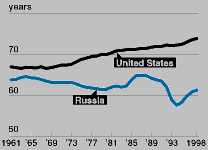
High Death Rate Among Russian Men Predates Soviet Union's Demise
Date
April 1, 2000
Author
(April 2000) There is good news and bad news for Russian men. The shocking increase in the mortality of Russian men has reversed in the last few years. But Russia would need years to catch up to levels of life expectancy that prevailed in that country in the early 1960s, let alone to reach the levels found in other industrialized countries now.
Male Life Expectancy at Birth.

Sources: State Committee of the Russian Federation on Statistics (Goskomstat) and the U.S. National Center for Health Statistics.
The increase in Russian death rates during the 1990s captured public attention. Nicholas Eberstadt, a scholar with the American Enterprise Institute, called it a “catastrophe of historic proportions,” involving far more premature deaths than were suffered by the Russian army in World War I. Life expectancy for men fell abruptly from a high of 65 years in 1987 to a low of 57 years in 1994, then rebounded to 61 years in 1998.
Most commentators have put the decline in the context of the economic and social turmoil following the breakup of the Soviet Union in 1989. But a team of Russian and French demographers collected several decades of time-series mortality data for the former Soviet Union and dated the decline to the early 1960s, long before the breakup.
For the first 40 or so years of its existence, the USSR enjoyed a remarkable improvement in health conditions, despite civil wars, internal repression, and world war. By the early 1960s, life expectancy had caught up with that in the United States. During the 1960s, though, life expectancy in the United States rose rapidly, while life expect-ancy in the Russian republic faltered and began to decline. The gap between East and West in life expectancy, like the gap in economic performance, grew steadily wider.
This trend was already apparent by the early 1980s. In a 1982 Population Bulletin published by PRB, Murray Feshbach, former chief of the U.S. Census Bureau’s research unit on the USSR’s population, noted “the mortality rise of the last decade and a half” and cautioned that “[I]f the health sector is neglected, the adverse mortality trend which has resulted in a major reduction in the life expectancy of Soviet males may persist.”
The story within the story came in the late 1980s, when then-President Mikhail Gorbachev instituted a vigorous antialcohol campaign as part of a wider effort to rescue Russian society, and the Soviet state, from self-destruction. The draconian, unpopular, and probably unsustainable campaign produced a sharp but temporary improvement in mortality rates. The collapse of the public health campaign, the collapse of the Gorbachev government, and the breakup of the Soviet Union nearly coincided in 1988 and 1989. The progress quickly made since the mid-1980s was just as quickly lost, and the long-term decline continued until the mid-1990s.
Cause-of-death data are difficult to use for comparisons over long periods or across countries with very different medical and statistical systems, but several independent analyses have come to the same conclusion: The decline in life expectancy and the gap between levels in Russia and the rest of Europe can be attributed mainly to abnormally high rates of cardiovascular disease and injury, for both of which abuse of alcohol was a major risk factor.
But limiting the comparison to the last 10 or 12 years is misleading. Comparing the unusually good years of 1986 and 1987, when the antialcohol campaign was most effective, with the lowest points of the mid-1990s exaggerates the speed of decline. Any other choice of start and end dates would produce a more characteristic picture of steady, long-term decline.
This is not just a historian’s quibble, since such comparisons have political meaning in Russia today. Dating every bad trend from 1989 fits in with revisionist nostalgia for the old days under communism. It also fits with the arguments made about giving foreign aid and policy advice to Russia: The catastrophe shows either the need for more aid and advice or the mess that comes of accepting either, depending on one’s point of view. Perhaps worst of all, the exclusive focus on the post-Soviet period obscures the achievement of the mid-1980s, which must rank as one of the most dramatic improvements in life expectancy ever induced by public policy. Surely there are some lessons from that experience, and an example of real accomplishment amidst the turmoil of the last days of the Soviet Empire, that could help Russians continue their recovery from their current troubles.
John Haaga is director of Domestic Programs at the Population Reference Bureau.
References
Vladimir Shkolnikov, France Meslé, and Jacques Vallin, “Health Crisis in Russia,” Population: An English Selection 8 (1996).
Alexandre Avdeev and Alain Blum, “La population russe : des raisons d’espérer ?” (‘The Russian Population: Reasons for Hope?’) Population & Sociétés 351 (November 1999). Available in French on the INED website: www.ined.fr/publications/.
Nicholas Eberstadt, “Russia: Too Sick to Matter?” Policy Review, no. 95 (June and July 1999): 3-26.
José Luis Bobadilla, Christine A. Costello, and Faith Mitchell, eds., Premature Death in the New Independent States (Washington, DC: National Academy Press, 1997).
